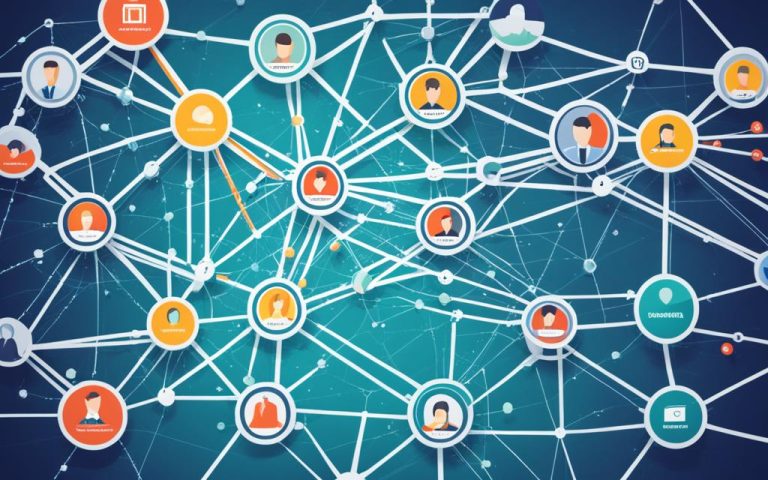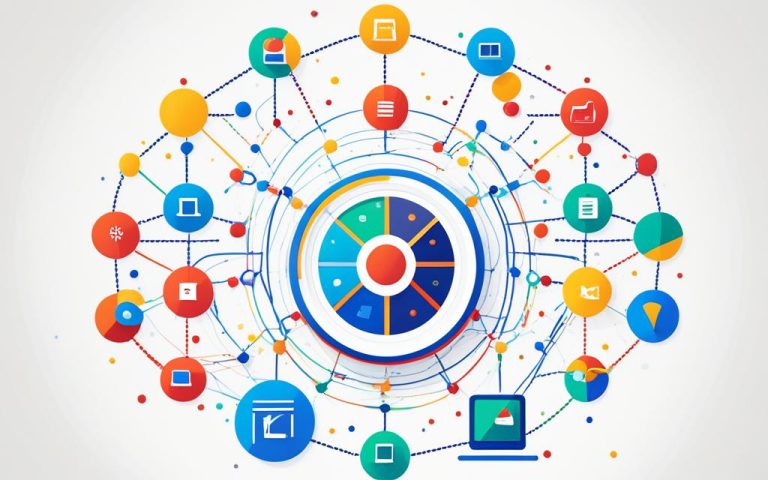Computer networks are key to our digital world, connecting people, devices, and resources. They make communication smooth and help use resources well. It’s important to know how they work to make the most of them.
ARPANET, started in the late 1960s, was a big step in creating today’s internet1. It was the first network that linked different networks together.
The Ethernet standard helps devices talk to each other over wires1. The 802.11 standard makes wireless connections strong, meeting our need for being connected everywhere1.
There are two main types of computer networks: client-server and peer-to-peer (P2P). Client-server networks have a central server that gives out resources. P2P networks spread the work and resources among all devices1.
Bandwidth shows how much data a network can handle at once. A bigger bandwidth means faster data transfer, which is important for today’s fast-paced digital world1.
The TCP/IP model is how computer networks are structured. It has layers like network access, internet, transport, and application. Each layer has a job, making sure data moves smoothly through the network1.
Computer networks have many benefits. They make sharing information fast and easy, helping people work together better. They also make using resources more efficient and keep data safe1.
There are many kinds of computer networks for different needs. You can find LANs, WANs, and even personal networks1.
Network providers are important. They give customers access to networks and services1.
Key Takeaways:
- ARPANET, from the late 1960s, was the first big network1.
- Ethernet and 802.11 standards are key for wired and wireless networks1.
- Networks can be client-server or P2P1.
- Bandwidth shows how much data a network can handle1.
- The TCP/IP model helps organize networks1.
- Networks have many benefits, like sharing resources and keeping data safe1.
- There are many types of networks for different needs1.
- Network providers are key in giving access to networks and services1.
How Computer Networks Operate Virtually
Computer networks can work virtually by splitting the physical network into logical parts. This lets us create many “overlay” networks where nodes connect virtually. Data moves between these nodes over several paths, making it more reliable and fast.
Virtual networks work by dividing the network into parts. This creates private areas for better data handling and security. These virtual networks sit on top of the physical network, giving a special space for certain users or apps.
Virtual Private Networks (VPNs) are a great example of this. A VPN is a small, virtual network that uses the internet for remote connections. It lets people access resources safely from anywhere, keeping their data private. VPNs are key for companies with remote workers, helping them connect securely from outside the office.
Other techs like Virtual LAN networks (VLANs) and Virtual Extensible LAN (VXLAN) also boost network security and organization. VLANs group devices on LANs, making it easier to manage and secure them. VXLAN uses tunnels to send data between devices, offering more scalability and flexibility.
Virtual networking brings many benefits, like better remote work, more security, and cost savings. With more people working from home, virtual networks and Network-as-a-Service (NaaS) are more important than ever. Using these networks can make companies more productive and help them change digitally.
By going virtual, computer networks can meet today’s business needs. They offer secure, efficient connections, save money, and adapt to new work styles. With logical parts, overlay networks, and virtual tech, computer networks support businesses and individuals in a changing world.
Comparison of Networking Technologies
| Feature | LAN Networks2 | MAN Networks2 | WAN Networks2 |
|---|---|---|---|
| Data Transmission Speeds | Higher | High-speed | Lower |
| Connectivity | Private Network Addresses | Optical Cables | Satellite Mediums |
| Maintenance Complexity | Easier | More Complex | More Complex |
| Data Security | High | High | Less Secure |
| Bandwidth | High | N/A | Limited |
references2
Integration on a Large Scale in Computer Networks
Modern networking services change how computer networks work. They bring together different networks on a big scale3. This makes networks work better through automation and monitoring, creating a single, strong network3. Being able to grow is a big plus, letting companies easily change their networks as needed3. This helps keep connections strong and lets businesses quickly adjust to new situations3.
Today, virtualized software-defined networks are key in bringing networks together3. They help manage traffic and control the network well, making sure data moves smoothly3. Automation makes sure the network works well, making integration smoother3.
When we talk about big network integration, we look at different network devices4. Things like Network Interface Cards, Bridges, Hubs, Switches, Routers, and Gateways are key. They help connect networks together and move data well4.
Protocols like TCP/IP, IEEE 802, Ethernet, wireless LAN, and cellular standards are vital for moving data around4. They make sure communication is smooth and safe, helping networks work together well4.
With lots of data moving around, keeping it safe is very important4. Networks have security tools like encryption and access control3. Adding things like antivirus software and firewalls helps protect data even more3.
How well a big network works is key4. Things like how fast data moves, how quickly it responds, and how many users it can handle affect its performance4. The type of hardware and network design also play a big role in how well it works4.
When things go wrong, having a reliable network is crucial4. How often it fails and how long it takes to fix it matters a lot4. A network that can keep going even when things are tough is very important for staying connected4.
Putting together big networks means thinking about security and performance3. Using strong security tools like firewalls helps keep data safe from hackers3. Also, having plans for fixing data problems makes the network safer4.
Integrated Network Components
| Component | Description |
|---|---|
| Network Interface Cards (NICs) | Enable data transfer between networks |
| Bridges | Connect multiple network segments |
| Hubs | Connect multiple devices within a network |
| Switches | Enable communication between devices in a network |
| Routers | Facilitate data transmission between networks |
| Gateways | Enable communication between different types of networks |
Quick Response to Changing Conditions in Computer Networks
Many computer networks today use software-defined networks (SDNs). These networks are flexible and efficient in managing and controlling traffic. They let organizations quickly adjust to changes and meet dynamic network needs5. SDNs use a digital interface to route and prioritize traffic well, ensuring top performance and flexibility.
When network needs change often, being quick to respond is key. SDNs make managing traffic efficiently possible, letting teams adjust resources as demands shift5. They can allocate bandwidth, prioritize traffic, and change routing as needed. This way, networks stay responsive and handle high demand and unexpected events well.
SDNs are great at fixing network problems fast. Network downtime can cost a lot, with losses in the hundreds of thousands to millions per hour5. So, quickly solving network issues is vital for keeping operations smooth and avoiding financial losses.
Fixing network problems involves several steps. First, identify the issue, then guess possible causes, test them, apply fixes, and check if they work. Keeping a record of these steps helps track issues, spot patterns, and make future fixes easier5. Tools like ping, tracert, and nmap help diagnose and fix network problems effectively5.
In summary, SDNs help networks quickly adapt to changes. They make it easier to manage traffic and improve performance in changing environments. Fast troubleshooting and command-line tools help networks respond quickly to problems, keeping operations running smoothly.
Data Security in Computer Networks
All networking solutions have built-in security features to keep data safe. These features are key to protecting sensitive info from unauthorized access. They help keep the network secure6. Encryption and access control are two main ways to do this.
Encryption makes data unreadable to others. It’s like a secret code that only the right person can understand6. This way, if someone tries to intercept the data, they won’t be able to read it.
Access control decides who can see or use certain parts of a network. It makes sure only the right people or devices can get to sensitive stuff6. This means network managers can set up rules for who can do what, keeping data safe from unauthorized access.
But, there’s more to keep data safe. Things like antivirus software, firewalls, and antimalware programs can be added to networks6. These tools help fight against malware, viruses, and unauthorized access. Using them helps organizations stay ahead in keeping their networks secure.
Data security is very important for computer networks. It makes sure sensitive data stays private and stops unauthorized access. With encryption, access control, and extra security tools, networks can stay safe from cyber threats.
In short, keeping data secure is a big deal in computer networks. Encryption and access control are basic security steps. Adding things like antivirus software and firewalls makes it even better6. These steps help protect sensitive data from cyber threats.
Understanding Types of Computer Network Architecture
Computer network architecture is key to how a network works and connects devices. It includes different designs that help decide how devices and resources are used in a network.
There are two main types: client-server and peer-to-peer architecture. Each has its own benefits and is used in different situations.
Client-Server Architecture
In client-server architecture, networks use servers and clients. Servers are powerful devices that store and manage data and applications. Clients, like computers or phones, ask for and use these resources.
This type of architecture is great for managing networks well. Servers handle client requests and keep things secure. It makes using resources efficient and keeps data in one place.
It has a clear structure where clients talk to servers for resources. They use special protocols to communicate safely and reliably.
GeeksforGeeks has lots of info on computer networking basics.
Peer-to-Peer Architecture
Peer-to-peer (P2P) architecture doesn’t need a central server. Instead, devices, or peers, share resources directly with each other.
This setup gives everyone in the network more control. Peers can share files or help each other out without needing a main server. It’s often used for sharing files and working together online.
By not having a central server, P2P networks can grow bigger and be more reliable. Each peer adds to the network’s strength and ability to handle tasks.
For more info on network architecture, IBM has lots of resources and expertise.
Knowing about computer network architecture is key for those who manage or design networks. It helps them pick the best architecture for their needs, thinking about things like size, security, speed, and cost.
The OSI model, with its seven layers, helps us understand network architecture better. Each layer has its own job and rules that help the network work well.
Many protocols, like TCP, IP, UDP, ARP, DHCP, and FTP, are used in the OSI model. They help make sure the network works smoothly.
Network architecture also includes technical stuff like private and public IP addresses. Private addresses are used in networks and often work with NAT to connect many devices. Public addresses let devices be reached over the internet.
Hardware like routers, switches, servers, and firewalls help networks work and keep data safe. Routers pick the best path for data, and switches make sure data gets to where it needs to go.
Devices use port numbers to talk to each other. There are different types of ports for different kinds of data. Sockets, which combine IP addresses and port numbers, help devices communicate.
DNS servers turn domain names into IP addresses, making it easier to visit websites. ARP changes IP addresses into MAC addresses for better data transfer. DHCP assigns IP addresses based on a device’s physical address.
Understanding network and internet architecture is vital for those who manage networks. It helps them design and maintain networks well. Knowing about the OSI model and its protocols ensures networks work reliably and efficiently.
Computer network architecture is a big and complex topic. It covers many concepts, protocols, and technologies. Staying updated with new developments is important for network professionals to keep networks running well.
The image below shows different types of computer network architecture:
Computer Network Architecture
| Network Architecture Type | Description |
|---|---|
| LAN (Local Area Network) | Covers a small area like an office or home, primarily used for connecting devices within a building or campus7 |
| WAN (Wide Area Network) | Spans a large geographic area, suitable for long-distance communication, such as connecting LANs within a city, country, or worldwide7 |
| Cloud Networks | Comparable to WANs, hosted on public or private cloud service providers, available on demand, utilizing virtual routers and firewalls7 |
| Client-Server Architecture | Involves servers managing client behavior within the network7 |
| Peer-to-Peer Architecture | Works without a central server, allowing each device to operate as a client or server7 |
Exploring Different Network Topologies
Network topology shows how devices and links are set up in a network. It’s key to how data moves and devices connect. Knowing about different topologies helps make networks work better and more reliably.
There are many network topologies, each with its own strengths and uses. Let’s look at bus, ring, star, and mesh topologies.
Bus Topology
In bus topology, all nodes link to a single channel, the backbone. This backbone is the main way data moves. Each node connects to the backbone with drop lines. It’s good for small networks because it’s simple and doesn’t cost much.[source]8
Ring Topology
Ring topology has nodes in a circle, forming a loop. Each node connects to its neighbors, making a path for data. It’s great for moving data fast and can handle a lot of data.[source]9
Star Topology
Star topology has a central hub that connects to many nodes. All data goes through the hub, making it easy to manage and secure. It’s good for its security and easy fixes since each node talks directly to the hub.[source]8
Mesh Topology
Mesh topology links every node to many others, offering many paths for data. In a full mesh, every node connects to every other. This makes it very reliable and flexible, but it can get complex as the network grows.[source]10
Choosing the right topology depends on the network’s size, how it needs to grow, and what it’s used for. Designers and admins think about these things to make sure the network works well and transfers data efficiently.[source]8
Network topology diagrams help show how networks are set up and how data moves. They’re useful for planning and fixing networks. They make it easier to spot problems and improve the network.[source]10
There are many tools and software for making and managing these diagrams. Tools like Datadog, Microsoft Visio, and SolarWinds help make network planning easier. They automate showing and keeping track of network layouts.[source]10
Knowing about network topologies is key for those who manage and design networks. It helps them make smart choices, improve data flow, and fix problems. The right topology can make networks run better, save money, and keep communication smooth.[source]98
Understanding Enterprise Computer Networks
Enterprise computer networks are key to modern organizations. They make sure communication, data sharing, and work flow well. These networks link devices, servers, and systems, helping employees work together and access what they need.
There are different types of these networks, each fitting an organization’s size and needs. Common types are Local Area Networks (LANs), Wide Area Networks (WANs), service provider networks, and cloud networks.
Local Area Networks (LANs)
LANs connect devices in one office, building, or campus. They let employees share files and use internal apps. LANs give fast, reliable connections, making work easier and teamwork smoother. They’re great for small projects or personal use in an organization.
Wide Area Networks (WANs)
WANs cover big areas, linking computers over long distances. They help with communication between different places, making sure data moves safely and quickly. With SD-WAN, WANs are now more flexible and efficient, making networks better and cheaper.
Service Provider Networks
Service provider networks are important for businesses. They offer network capacity and services from companies like telecoms and ISPs. This lets businesses use outside help for their networking, focusing on their main work.
Cloud Networks
Cloud networks have changed how businesses handle IT and services. They use cloud services to host resources and apps on demand. Most IT services are now from data centers and cloud networks, offering cost savings and better performance. This lets businesses grow and reach users everywhere.
Knowing about different enterprise computer networks helps businesses pick the best network setup. Whether it’s a LAN for local use or WANs and cloud for global offices, a strong network is key for smooth and secure work.
References:
[1] Statistical data extracted from11
[2] Statistical data extracted from12
[3] Statistical data extracted from11
AWS Computer Networking Services for Enterprises
AWS offers a wide range of computer networking services for enterprises. These services make networks secure, fast, and always available. They help improve security, make networks more reliable, and speed up data transfer.
AWS focuses a lot on keeping networks safe. For example, AWS CloudFront has a pay-as-you-go pricing model. This makes it easy and affordable for companies to use secure networks for delivering content. It keeps data safe and ensures it’s not tampered with, which is crucial for businesses13.
Enterprises can count on Amazon Route 53 for reliable network access. It offers different ways to route traffic, like by speed, location, or weight. This lets companies direct traffic to the best network resources worldwide. AWS Verified Access checks each request in real time to make sure it’s secure, boosting security and access control for company apps13.
Amazon VPC helps set up secure networks by letting companies create public and private subnets. Public subnets face the internet, while private ones don’t. This keeps apps safe and running smoothly13.
AWS App Mesh makes sure microservices talk to each other well. It gives full visibility and keeps applications running smoothly on AWS. This means better performance for networked apps by improving communication between services13.
AWS Cloud Map helps with finding resources quickly. It lets apps find the latest locations of resources easily. This means apps can always get to the resources they need, making them more available13.
AWS Direct Connect gives a direct link between AWS and a company’s location. This cuts down on network costs and boosts speed. With faster and more reliable connections, companies can move data quicker to their AWS resources13.
In summary, AWS networking services give companies secure, fast, and reliable networks. They offer top-notch security, high availability, and fast data transfer. With AWS, companies can build strong networks that support their work and give users a great experience.
Using AWS Networking Services
Organizations can use AWS networking services to boost their network setup. Services like the Amazon Virtual Private Cloud (VPC) and AWS Private Link help connect on-premise networks with the AWS cloud safely. This makes data transfer smooth and integration easy.
With AWS networking, creating Virtual Private Clouds (VPCs) is possible. These VPCs are secure and isolated. They can have many subnets, with a subnet-to-VPC ratio for better network control and resource use14.
AWS networking also lets you pick your own IP addresses for VPCs and subnets, including IPv4 and IPv6. This lets organizations tailor their network addresses to fit their needs14.
For network security, AWS has strong defenses against cyber threats. Security groups and network access control lists help control who can access Amazon EC2 instances in each subnet. This adds multiple security layers to resources14.
Keeping an eye on network traffic is important for security and management. AWS has traffic distribution features. These let organizations send network traffic to security and monitoring tools for detailed checks14.
Connecting to the internet and AWS services is key in AWS networking. Organizations can make gateway connections and use VPC endpoints for private access to AWS services. This gives flexibility and ensures good performance14.
Also, AWS networking supports VPC peering connections. These let organizations share resources and traffic between VPCs. This makes working together easier and operations smoother14.
For better visibility and troubleshooting, VPC flow logs are useful. They record IP traffic to and from network interfaces in a VPC. This helps with analysis and monitoring14.
For safe connections between AWS and on-premises networks, AWS VPN connections are used. These connections protect data as it travels over public networks. This ensures secure communication and data transfer14.
Using AWS networking services helps organizations improve their network setup, security, and management. These services are reliable and scalable for businesses of all sizes. They help drive growth and success in the cloud.
The Benefits of Computer Networking
Computer networking brings many benefits for both people and businesses. It makes sharing data and working together easier between devices. This leads to better teamwork and more work getting done in many areas.
Sharing resources is a big plus of computer networking. People and companies can use things like printers and storage together. This saves money and makes things run smoother. It helps companies work better and use their resources well.
Computer networking makes things more efficient. It helps automate processes, making businesses run smoother. Automation is key in the future of networking, making things faster and less prone to mistakes.
As shown in15, computer networking is everywhere in business today. Almost every company uses it for online work. And15 says it has helped e-commerce grow by letting businesses reach more customers worldwide. This shows how big the benefits of networking are.
Networking has changed how we work from home, especially during the COVID-19 pandemic, as15 notes. It lets people work remotely, which is good for both workers and companies. It makes working together easier, even when you’re apart.
For storing and getting to data, computer networking is a big help. Cloud computing, made possible by networking, is getting more popular for storing and accessing data and apps, as15 points out. Cloud services offer flexible and scalable storage, making it easy to work together and keep data safe.
Networking also helps in healthcare, like with telemedicine, as15 shows. It lets doctors and patients talk remotely, making healthcare better for people in remote places or with limited access.
In summary, computer networking has many benefits. It helps with communication, sharing resources, and making things more efficient. These benefits make businesses more effective and competitive in today’s connected world.
| Benefits of Computer Networking |
|---|
| Improved Communication |
| Efficient Resource Sharing |
| Enhanced Efficiency and Automation |
| Global Reach of E-commerce |
| Facilitation of Remote Working |
| Cloud Computing for Data Storage and Access |
| Telemedicine Services and Healthcare Access |
Conclusion
Computer networks have changed how we talk and share things online. They work without physical wires, making it easy to connect and send data. In the 1990s, as the world economy grew, networks became key for sharing knowledge and resources worldwide16.
Network science became a big deal, covering engineering, biology, and social networks16. But, there’s a gap between how networks help us and their role in military and research16. Experts agree on what network science should focus on, like how networks change, modeling big networks, and making the field more rigorous16.
Building computer networks means knowing the different types and how they’re set up. LANs, WANs, and others help build networks17. Things like switches and routers are key for a strong network17. Also, protocols at various layers make sure data moves smoothly17.
Services like AWS improve how networks work for businesses18. LANs give fast, private connections, while WANs help with global data sharing18. CANs are great for quick data transfer and connecting different departments without spending too much18. Each network type has its own strengths for different needs18.
At the end, computer networks have given us big benefits. They make things more efficient, help us work together, and keep data safe in many areas. By using networks, we can handle the digital world’s challenges and open up new chances for everyone1718.
FAQ
What are computer networks?
Computer networks connect devices like computers and servers. They help with communication and sharing resources.
How do computer networks operate virtually?
They work virtually by breaking down the physical network into logical parts. This creates “overlay” networks for data to move through different paths.
What is integration on a large scale in computer networks?
It means linking many networks together. It also means making network functions better and growing services as needed.
How do computer networks respond quickly to changing conditions?
They use software-defined networking. This helps manage traffic and control it efficiently.
How are data security features implemented in computer networks?
They have built-in security like encryption and access control. You can add more security with antivirus software and firewalls.
What are the different types of computer network architecture?
There are client-server and peer-to-peer architectures. In client-server, some nodes are servers and others are clients. In peer-to-peer, all computers are equal.
What are the different network topologies?
Topologies include bus, ring, star, and mesh. Bus links nodes in a line. Ring forms a loop. Star has a central server. Mesh connects all nodes directly.
What are the types of enterprise computer networks?
They include LANs for a single office, WANs for wider areas, service provider networks, and cloud networks on the cloud.
What computer networking services does AWS offer for enterprises?
AWS provides secure, reliable, and fast networking services. These include security measures, high availability, and quick performance with low delay.
How can organizations use AWS networking services?
They can use AWS networking services like Amazon VPC and AWS Private Link. This helps create secure Virtual Private Clouds and connects on-premise networks to the AWS cloud.
What are the benefits of computer networking?
Networking improves communication and sharing of resources. It makes processes smoother and automates them. This leads to more productivity and success in many areas.
Source Links
- https://www.techtarget.com/searchnetworking/definition/network – What is a Computer Network? | Definition from TechTarget
- https://www.simplilearn.com/tutorials/networking-tutorial/importance-of-types-of-networks-lan-man-wan – Importance of Types of Networks: LAN, MAN, and WAN | Simplilearn
- https://aws.amazon.com/what-is/computer-networking/ – What is Computer Networking? – Networking in Computers Explained – AWS
- https://www.geeksforgeeks.org/what-is-computer-networking/ – What is Computer Networking? – GeeksforGeeks
- https://www.comptia.org/content/guides/a-guide-to-network-troubleshooting – A Guide to Network Troubleshooting
- https://privacy.microsoft.com/en-us/privacystatement – Microsoft Privacy Statement – Microsoft privacy
- https://www.geeksforgeeks.org/basics-computer-networking/ – Basics of Computer Networking – GeeksforGeeks
- https://www.itglue.com/blog/network-topology/ – What is Network Topology? Types & How to Map It | IT Glue
- https://www.geeksforgeeks.org/types-of-network-topology/ – Types of Network Topology – GeeksforGeeks
- https://www.techtarget.com/searchnetworking/definition/network-topology – What Is Network Topology? – Definition from SearchNetworking
- https://www.bmc.com/blogs/enterprise-networking/ – Enterprise Networking Explained: Types, Concepts & Trends
- https://www.techtarget.com/searchdatacenter/definition/IT – What is information technology? | Definition from TechTarget
- https://docs.aws.amazon.com/whitepapers/latest/aws-overview/networking-services.html – AWS Networking and Content Delivery category icon Networking and content delivery
- https://aws.amazon.com/getting-started/aws-networking-essentials/ – AWS Networking Essentials
- https://www.geeksforgeeks.org/advantages-and-disadvantages-of-computer-networking/ – Advantages and Disadvantages of Computer Networking – GeeksforGeeks
- https://nap.nationalacademies.org/read/11516/chapter/10 – 8 Conclusions and Recommendations | Network Science
- https://www.techtarget.com/searchnetworking/definition/networking – What Is Computer Networking? | Definition from TechTarget
- https://www.geeksforgeeks.org/types-of-computer-networks/ – Types of Computer Networks – GeeksforGeeks



















